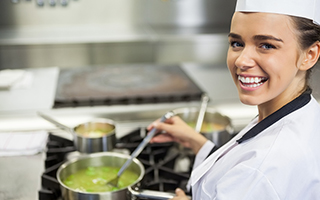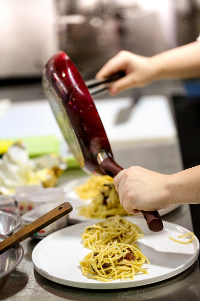Get started now.


Culinary schools across Canada specialize in helping food enthusiasts become skilled professionals in an industry built on delighting people with creative presentation, delicious flavours, and warm hospitality. They understand what's involved in becoming someone who can work at a high level within commercial kitchens or bakeries. And they tailor their training programs toward the goal of ensuring that students get the opportunity to begin their culinary journeys with plenty of confidence.
By exploring this guide to Canadian culinary schools, you can find a program to help you prepare to become a chef or another type of professional in the food industry. You could opt for a program focused on restaurant management, baking and pastry, catering, culinary arts, or even wine and spirits.
If you're looking to find out the typical chef education requirements in Canada, average salary rates, or other important information, this article can answer all of these questions and more.
Sponsored Listing
 The food industry has become huge over the past decade. Food television shows and even 24/7 networks have risen in popularity, along with magazines, cookbooks of every kind, and too many food blogs to count.
The food industry has become huge over the past decade. Food television shows and even 24/7 networks have risen in popularity, along with magazines, cookbooks of every kind, and too many food blogs to count.
Food has even become a mainstay of the social media world, with people sharing tips, recipes, and photos of their creations on sites like Facebook, Twitter, Pinterest, and Instagram.
All of this focus on food may have made people more interested in learning how to cook amazing meals themselves, but dining out continues to be hugely popular. Restaurants of every kind, from fine dining establishments and cafés to diners and bistros, and even food trucks, are hot spots across the country. Some cities are even becoming known primarily for their amazing food scene. This makes the culinary field an exciting career choice for those with the passion and drive to enter this challenging but thrilling industry.
"Chef" may seem like a pretty straightforward title and position, but it's a very broad term used to describe anyone who cooks for a living. The reality of the industry is that it takes many different individuals working in many different positions to keep a culinary business running smoothly and profitably.
The end goal is always to provide customers with not only great food, but also great service. That means never making a customer wait too long for his or her meal. In order to accomplish this goal, chefs have to work together seamlessly to ensure perfect timing for each customer's order. And that is the reason most restaurants follow what is known as a "brigade de cuisine," or "kitchen brigade."
The Brigade de Cuisine
Coined in the military, the term "brigade" refers to a tactical formation of organized troops. In a large commercial kitchen, a brigade system is used to organize chefs by rank (based on experience and skill level) and station (based on the type of food they prepare).
The brigade system defines each of the different positions and the responsibilities associated with them.
A common brigade de cuisine system is organized in this order, from highest to lowest ranking:
Executive Chef
Sous Chef
Station Chef
Tournant
Commis
Other Positions
Many additional positions outside of a restaurant require a chef's skills. Some of the most common positions include:
Food Preparation
Kitchen Management
If you have a high-ranking position in a large kitchen, work in a small kitchen with fewer employees, or own your own restaurant, you will likely have to take on these additional tasks:
Tasks Outside of a Commercial Kitchen
 If you work in a chef-related position outside of a traditional commercial kitchen, your duties can vary.
If you work in a chef-related position outside of a traditional commercial kitchen, your duties can vary.
For example, a caterer often prepares specifically requested dishes and is responsible for bringing the food to a remote site and either setting it up buffet-style or serving it to clients restaurant-style.
A private chef is typically required to cook within a client's home, either preparing a week's worth of meals for the client to reheat or preparing and serving each individual meal.
A food product developer usually works in a large industrial kitchen, creating and testing new products or recipes and setting guidelines for mass production.
The most common working environments for chefs include:
Salary rates can differ depending on factors like:
But, to give a general picture of salary rates, Government of Canada Job Bank statistics gathered on March 4, 2022, show that the national averages for chef salaries were as follows:
Paid Apprenticeships
It is also important to note that you could earn a salary while working as an apprentice. In most cases, apprenticeships are actual paid positions (although at a lower wage than a fully trained chef). This helps offset the cost of training and allows you to earn a pay cheque while you learn the ropes of the industry.
Food is at the very heart of many Canadian cultural traditions. And just about everyone enjoys being treated to a fine meal prepared by chefs or cooks who have the skills and creativity to produce something that most of us wouldn't be able to create ourselves. Good food simply feeds the soul. That's a big reason why we now celebrate so many of today's master chefs.
Plus, the restaurant industry alone demonstrates how important professional food services are to Canadians and the overall economy. Check out these numbers:
Of course, restaurants are only part of the story. As an aspiring chef or culinary arts enthusiast, you can find appealing opportunities in hotels, healthcare facilities, cruise ships, and many other types of settings.
Chefs are not regulated in Canada, and specific certification is not technically required in order to work as one in this country. However, certification is strongly preferred by many employers. Plus, getting professionally certified is an excellent way of proving to future employers that you are committed to the industry and possess skills that meet industry-standard requirements and expectations. It can also be a good way of showing that you are open to continuously learning and striving to improve your skills.
Certification options in Canada include:
Red Seal Certification
Red Seal certification tends to be the most common in Canada, and it is the highest level of government-endorsed certification. There are multiple routes you can take to meet the certification exam prerequisites, including:
One of the main benefits of pursuing Red Seal certification is that it is designed to be interprovincial, meaning that the criteria and standards have been set and jointly agreed to by multiple provinces and territories.
In the case of Red Seal Professional Cook certification, it has been approved and adopted by all provinces and territories, except Nunavut, Saskatchewan, and Quebec. That means you can work as a chef within any province or territory (excluding the three exceptions) without having to worry about additional location-specific certification.
Canadian Culinary Institute
Another common source of industry certification is through the Canadian Culinary Institute (CCI), which operates under the Canadian Culinary Federation (CCF). The CCI works with a selection of post-secondary culinary institutions in order to oversee the delivery of certification programs and evaluate students who want to be considered for industry certifications.
Various CCI certification levels are available. But, overall, they are intended for experienced chefs who are looking to receive advanced certification credentials. Each one has a specific set of prerequisites. For some, you must hold Red Seal Journeyman status. Others require that you complete a post-secondary program from a CCI-approved school.
Official CCI certifications include:
Since chefs are not regulated in Canada, there isn't one specific set of education requirements across the board. Different employers can have different preferences. However, most employers do prefer to hire people with the following credentials:
Why Culinary School is a Good Option
One of the benefits of attending a vocational school is that you can often find one that is associated with an apprenticeship program. This means you can get the best of both worlds—formal education at the post-secondary level and real-world experience through a paid apprenticeship position.
The only prerequisite typically associated with culinary programs is having a high school diploma (or equivalent).
Culinary schools frequently offer a variety of program options. However, if you are looking to obtain the education needed to become a chef, the most common choice of program tends to be culinary arts.
The curricula can vary by school, but the most commonly covered areas are:
Theory, Safety, & Business Training
Practical Kitchen Training
Hands-on Culinary Experience While in School
Many culinary schools operate some type of on-site restaurant, café, or catering service. They tend to be run entirely by students under the supervision of instructors and are often open to the student population and/or the public.
For additional real-life experience, some programs also include an externship within a local business. Alternatively, if you choose a program that is associated with an apprenticeship program, you will generally obtain theoretical and practical training through the school and then gain real-life experience as an employer-sponsored apprentice.
Alternative Culinary-Related Program Options
Perhaps you've decided on culinary-related training but are looking for something other than a culinary arts program. Examples of other common programs include:
Baking and Pastry Arts
Hospitality/Restaurant Management
The exact length of a culinary program will depend on a few different factors, such as the type of program you choose, the type of school you attend, and whether or not there is an affiliation between the school and an apprenticeship program.
Here are some general guidelines for culinary program length:
When determining the cost of your schooling, it's important to find out exactly what is included in the tuition fee. Some schools may include the cost of books, supplies, and equipment within tuition, whereas other schools may split these costs up.
Most schools are able to offer (or facilitate) some form of financial aid for qualified students. This could include private loans, government loans and grants, scholarships, work-study programs, or veterans' benefits.
According to Job Bank, the job outlook for chefs in Canada looks fairly positive. Between 2015 and 2024, about 24,300 new job openings are anticipated to become available. About 56 percent of those openings are expected to be created due to expanding demand. And another 35 percent of the openings could be generated by current chefs reaching retirement age.
Some of the main areas of employment for chefs are:
Outside of education and experience, certain natural abilities and traits can contribute to a successful career as a chef, such as:
 The most obvious reason to become a chef is because you have a true passion for food. But some other common factors considered a "cherry on top" are:
The most obvious reason to become a chef is because you have a true passion for food. But some other common factors considered a "cherry on top" are:
It's Fun!
Being a chef involves working in a fast-paced, exciting environment that tends to get your adrenaline pumping. As any adrenaline junkie can tell you, nothing beats that "on top of the world" feeling.
Advancement Is Encouraged
Thanks to the brigade de cuisine system, the culinary ladder is there to be climbed. Knowing that progression and advancement are there for the taking can be an incredible source of satisfaction and motivation.
There's Never a Lack of New Challenges
Working in a kitchen can give you the opportunity to constantly challenge your skills and abilities and strive for continual improvement. It's an industry where you truly can learn something new every day because the sheer varieties of food and ingredients make for endless possibilities when it comes to new recipes. This can keep your job fresh and engaging.
Food Is Always in High Demand
Everyone enjoys a break from cooking at least once in a while. That's what makes the restaurant industry so popular and dining out such a common "small luxury" for people to treat themselves with.
Opportunities Abound
Even the smallest towns tend to have at least one restaurant. And, due to the massive amount of work that goes into operating a commercial kitchen, most restaurants always have work to be done and are open to new employees. It's comforting to know that a steady paycheque can almost always be found.